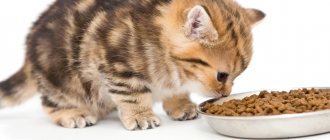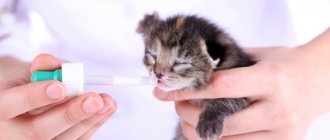Home » Useful Information
Weight gain during the period of active growth of a kitten plays a big role. Monitoring this indicator is important so that deviations can be noticed in time and the causes that caused them can be eliminated. To make it easier to keep weight characteristics under control, you can use special tables.
- 2 Why do you need to monitor a kitten’s weight at different periods of its growth?
2.1 What is a weight diary
- 3.1 Video: how to weigh a cat
- 4.1 Table: average body weight of kittens in the first 6 months of life
How does a kitten's weight change as it gets older?
If babies are healthy, they will gain weight daily. A day after birth (second weighing), the weight of newborns, if they are not sick, will increase by at least 8-10 g. The strongest kittens gain 14 g in weight by the second day of life. If a baby whose weight at birth corresponded to the norm, during the second day of life he did not gain at least 7 g, this should alert the breeder.
A newborn baby should weigh up to 170 g
During the first week of life, a newborn's weight may double.
Important! The kitten, who lived for 10 days and gained 168-174 g, has passed the first critical milestone. The majority of newborns die during this period. Almost always the cause of death is a lack of mother's milk.
Kittens are fed around the clock at intervals of two hours. When eating, the kitten should lie on its stomach. It is unacceptable to feed your baby adult food, such as cow's or goat's milk. This can cause diarrhea and, as a result, weight loss and death. The breeder must also weigh the kittens daily and record the results.
Third month of life
Kids at this age are alert and active; they spend most of their time playing and exploring their property. They ride on curtains, climb on sofas, beds, carpets on the wall. Not only the weight but also the growth of the kitten increases, the formation of the skeleton and muscles occurs. During this period, it is important to introduce more foods rich in vitamins, minerals and proteins into your diet. You can continue to feed your pet natural products or choose food designed for three-month-old kittens.
Combination nutrition is not recommended, since it is difficult to achieve the optimal balance of all necessary vitamins and microelements. Therefore, it is better to immediately make a choice: natural food or ready-made food (dry and wet). If you decide to feed with special foods, then you need to purchase premium formulations. This guarantees their quality and the future health of the animal.
By choosing ready-made food, the owner solves several problems at once:
- There is no need to compile a daily menu; it is enough to pour the amount of mixture indicated on the pack of food;
- time spent on shopping trips is reduced. It is enough to visit a pet store and purchase a supply of food so as not to go to the market every day in search of fresh food for your pet;
- the finished formulations are balanced, so there are no problems with nutritional quality.
By this age, the weight of the growing young is from 1.2 to 1.7 kg.
How much should a cat weigh at different stages?
Chihuahua weight by month and week: table
During the first 15–20 days of life, kittens spend most of their time sleeping. After about 16 days from the moment of birth, babies begin to be interested in the events happening around them, frolic and play.
The table shows the weight of a growing kitten by month:
| Kitten age | Kitten weight by month | Note |
| 1st day of life | Approximately 99 g | Average weight of a newborn kitten |
| 7th day of life | 149 g | If a 7-day-old kitten weighs less than 99 g, he is either seriously ill or malnourished. |
| 14th day of life (0.5 months) | 170 g | The weight of a kitten is given, which is not sick with serious illnesses, but also does not receive the maximum portion of attention. |
| 21 days of life (0.7 months) | 225 g | With special care, kittens reach the specified weight at the age of 14 days |
| 35th day of life (1.2 months) | 450 g | The weight of an absolutely healthy, naturally strong kitten is indicated. |
| 2 months from the date of birth | 900 g | The cat no longer feeds her kittens; their future fate depends entirely on the owner. The permissible minimum weight at this age is 710 g |
| 3 months | 1400 g | The average weight of a typical kitten is indicated. |
| 4 months | 1800 g | Average weight |
| 5 months | 2300 - 2900 g | Male kittens weigh more than their sisters |
The table shows the average weight. The exact indicators depend on the breed, gender and health status of the kitten.
Outbred kittens develop in approximately the same way as purebred kittens, only their mortality rate is higher due to the lack of additional nutrition.
A weak kitten weighs very little from the first days of life
Note! An animal that at the time of birth weighed less than its littermates will not be able to do without additional nutrition. Pushed away from his mother's nipples by stronger brothers and sisters, he does not receive enough nutrition, does not gain weight and becomes weaker.
Kittens stop needing mother's milk within a month after birth. By this time, their fangs and incisors have erupted, their ears take a vertical position (in representatives of straight-eared breeds), and their weight reaches 440-470 g. A kitten that has reached six months of age is considered an adult and weighs about 3 kg.
Why is the baby overweight and is it dangerous?
At this age, this problem is most often associated with overeating and insufficient physical activity. In most cases, this disorder is diagnosed in domestic cats that do not walk outside.
Most often, the problem of excess weight is solved by reducing portions. As a rule, at 7–9 months, at the height of puberty, the cat’s weight returns to normal. Much less often, obesity becomes a consequence of systemic diseases. To determine whether excess weight indicates pathology, you need to examine the kitten's waist. Normally, the ribs should not be noticeable, but easily palpable. If your fingers “sink” when you feel them, it is difficult for the animal to move, it is lethargic and apathetic, you need to contact a veterinarian.
Source
Rules for weighing kittens
German Shepherd weight by month: table
Kittens must be weighed every day. If they look healthy, once is enough. Sick newborns, as well as those whose weight at birth was less than 80 g, are weighed twice a day. The weakest and most disease-prone babies are usually born in large litters (5 or more kittens).
Important! Experts recommend weighing them at the same time to get the best idea of newborns' rate of weight gain. Without this, the breeder will not be able to determine the amount of additional nutrition. Overfeeding kittens is no less difficult than underfeeding.
During the weighing session, the mother cat must be kept near the kittens so that she can see what is happening with her children. Excessive worry can negatively affect the quality of mother's milk. To create the most accurate picture of kittens growing up, experts advise:
- Mark identical kittens with different colored food dyes. This will make it easier to identify them. The tags will have to be periodically updated, since the cat, licking the babies, will wash them off;
- use electronic kitchen scales as the most accurate;
- record weighing results.
Six months
At this age, the kitten has already grown to the size of an adult animal. The process of puberty can lead to estrus in cats and unplanned pregnancies, so girls need supervision. During this period, the first molt is observed.
Muscle mass and bones are not yet fully formed, so the weight of pets continues to increase, but at a slower pace. By the age of six months, the weight of the animal averages 3 kg.
Weight gain ends around the age of two. Bones and skeleton, as well as muscles, stop growing, and weight fluctuations may depend on changes in adipose tissue.
What does weight depend on?
Yorkie weight by month: table, standard, how many months it takes to grow
Male kittens weigh more than females as they grow up. With each new weighing, the difference increases. The weight of mature males and females is influenced by a number of factors.
Bengal cats
During the first week of life, the weight of a Bengal kitten can reach 250 g, and after another three weeks the baby will weigh from 400 to 500 g. A three-month-old teenager weighs about a kilogram.
A Bengal kitten reaches 1 kg at 3 months
Bengals are a fairly heavy breed, but they are never fat. Kittens are very active and energetic, they run a lot, they are always in excellent physical shape, although they look well-fed and even overfed. They owe their appearance to their natural muscularity.
Note! The weight of a Bengal kitten depends to the greatest extent on the development of its muscular system. We must not forget that Bengals are big-boned animals.
"British"
On the 7-8th day of life, 70-gram babies already weigh 110-150 g. When they are two weeks old, their weight will increase to 210-420 g. The specific weight depends on gender, health status and the number of kittens in the litter.
Scottish Fold
If at birth cats of this breed weigh 70-120 g, then after two weeks these figures increase to 440 g. A two-month-old “Scottish” kitten weighs about 800 g. After another month and a half, its weight will increase to 1.5 kg.
Representatives of this breed, even when they grow up, do not cease to look like teddy bears with a rounded head on a short neck and large, widely spaced round eyes. Males that have reached puberty weigh from 4 to 6 kg, and females - from 2.7 to 4 kg.
“Scots” are usually good-natured and calm. They love to be outdoors and never miss an opportunity to participate in outdoor games. Loneliness and a sedentary lifestyle make them depressed and, as a result, lead to obesity.
Siberian cats
Siberian cat kittens are born weighing 60-130 g. Girls and the weakest newborns weigh less, boys, as well as kittens born at the beginning of the litter, have the greatest weight. During the first month of life, their weight increases by 12-15 g daily.
Sphinxes
Representatives of this species require high-calorie food to avoid hypothermia. The weight of females that have reached the age of 8-9 months can reach 3-4 kg. Males weigh from 4 to 5 kg.
The Sphynx needs to be fed a special diet
Sphynx kittens are not separated from their mother until they are one month old. During this period they feed on her milk.
Thai cats
The weight of a 3-month-old male can reach 1.8 kg. A female at this age weighs about one and a half kilograms. When the kittens are six months old, the male will weigh approximately 2.9 kg and the female 2.3 kg.
Why do you need to monitor a kitten’s weight at different periods of its growth?
A kitten's weight is a very important aspect of its development. The baby's weight needs to be monitored for several reasons. For example, by the age of one month, a kitten can weigh up to 500 grams. If his weight differs from this indicator in the direction of decrease, this may be caused by the following reasons:
- diseases, congenital or acquired;
- numerous litters;
- the mother’s lack of a complete diet that can provide nutrition for both the cat herself and her babies.
During the feeding period, the cat's food volume should be increased by 30% of the normal daily intake.
An underweight kitten may indicate that the baby is malnourished. He becomes lethargic, sleeps a lot, and apart from the general mass of kittens. In this case, you need to increase the amount of food for the nursing cat and monitor how long the weak baby stays at her breast.
Once I brought foundlings to my nursing cat. They were left without a mother, and besides, unkind people simply abandoned them to their fate. The two babies quickly got used to it, actively sucked the cat and did not differ from her “native” kittens. One kitten was very weak, he could not defend his place at the nipple and was often left out of work. Sometimes he still managed to get comfortable, but he quickly got tired and soon fell asleep without having eaten enough. Since I closely followed the adaptation of foundlings, I immediately noticed this (literally within 24 hours). The baby had to be fed separately. I gave him a special mixture, but also tried to get him to latch on to the cat’s breast more often (the more lively brothers had to be pushed aside for a while). As a result, this baby still lagged behind the others in weight, but caught up with them in height by about a year.
If a kitten is diagnosed with any disease, then to correctly calculate the medicinal suspension you will also need to know the exact weight of the animal. Therefore, a conscientious owner always monitors this indicator.
What is a weight diary
Every caring owner should keep a kitten's weight diary. This must be done regardless of whether the kitten grows up alone or with its mother cat and brothers. It is necessary to record all weight indicators in the diary, which can later help track whether the baby is developing normally.
The weight diary can be kept in any form, as convenient for the owner. This is an ordinary notebook for me. In it I write down the date of birth of the kittens, the names I gave them, as well as everything related to caring for them. This is not only their weight, but also the dates of treatment for fleas and worms, as well as the dosage of drugs (which, by the way, depends on weight). This is very convenient because over time I forget when, for example, I processed animals. A hint notebook helps me remember, especially since I now have 4 cats and a dog, so it’s quite possible to forget or confuse something.
How to prevent obesity in kittens
The change in nutrition plan is carried out gradually. Experts advise extending the transition to a diet for 7-14 days. If the kitten does not receive its usual food for 3 days, and the new food is not to its taste, the period of forced fasting may affect the functioning of the liver. The best way to transfer an animal to a new food system is to gradually, in small portions, replace the usual food with dietary food.
Important! To prevent the kitten from overeating, portions must be dosed, and feeding should be done strictly according to the clock. If food is constantly at the animal’s disposal, it will be difficult for the owner to keep track of exactly how much the baby eats and at what time.
After filling the bowl with food, leave it for about 20 minutes and then remove it until the next meal. If the cat has already reached adulthood, it is recommended to give food 3-4 times a day during the first week, and 2-3 times a day during the second week. Ultimately, the daily dose is divided into 2 doses.
Portion sizes depend on the type of food and calorie content. The animal should receive the recommended daily dose corresponding to its weight (indicated on the package).
Features of development in the second month of life
By the end of the fourth week, the baby's teeth are forming, so feeding on mother's milk alone is no longer enough. The kitten gradually begins to try new food. The diet can include chopped boiled meat, sea fish, and canned food for small kittens. Complementary foods are allowed to be given in small portions, divided into 6 doses.
Babies also need water. A bowl of water should be within easy reach of them. Kittens become more active at this time and therefore need supervision from the owner. They strive to get out of the place allocated for them and explore the surrounding area, which is fraught with falls and injuries.
How much should a grown-up cat and cat weigh?
Bengal kittens stop growing when they reach 2 years of age. By this time, the weight of the female can reach from 3600 to 4500 g. The male will weigh 4500-6800 g. In some cases, the weight of an adult male Bengal can reach 10 kg or, conversely, not reach the norm (the minimum weight of a male is 3600 g), but This is rather an exception to the rule, rather than the norm. The same can be said about females. Female cats sometimes weigh much more than males.
Many breeders of Bengal cats believe that the weight of their pets exceeds the norm or, conversely, is below the acceptable minimum. The fact is that cats of this breed remain children longer than their relatives. They usually reach full physical development at the age of 3 years or so.
“The British” do not control their food intake, which is why they later suffer from obesity
Important! A peculiarity of British cats is their tendency to obesity. If the breeder does not regulate the pets' diet, they quickly gain excess weight.
Table for calculating the weight of a mature British cat by age.
| Gender | Permissible minimum weight | Permissible maximum weight | Expert opinion |
| 2 year old male | 4.1 kg with a height of 40 cm | 7.7 kg with a height of 50 cm | 6 kg regardless of height |
| 2 year old female | 3.2 kg with a height of 35 cm | 5.4 kg with a height of 45 cm | 5 kg regardless of height |
If the British dog's weight falls far short of the acceptable minimum, the breeder should think about additional nutrition. A veterinarian will help you decide on the amount and composition of feeding. The procedure for treating obesity in cats is not much different from the treatment for people suffering from excess weight. The best cure in both cases is diet and physical activity. If an obese kitten whose body is constantly growing, he most likely leads a sedentary lifestyle and receives an excessive amount of food. It is enough for the breeder to change the lifestyle of the ward.
For mature Siberians, a weight of 4 to 10 kg is considered normal. Both males and females are distinguished by their large dimensions and powerful muscular bodies. Female Siberian cats weigh between 4 and 6 kg. Males, if not sick, reach 6-10 kg.
For your information! To find out how much a Siberian cat weighs, you will need a bathroom scale. Experts suggest the following method: the breeder first weighs himself, and then, picking up the cat, weighs himself again. All that remains is to calculate the difference.
Thai male cats, upon reaching maturity, weigh from 5 to 6.8 kg. The weight of mature females ranges from 3.6 to 5.4 kg. Cats of this breed are natural gourmets; they never miss an opportunity to eat deliciously, so breeders have to constantly monitor their weight.
Detailed schedule
A detailed chart of weight gain in domestic cats is as follows:
- newborn babies: females – 116–145, males – 118–147 g;
- 1 week: 240–260, 240–280 g;
- 2 weeks: 340–400, 350–420 g;
- 4 weeks: 560–740, 630–820 g;
- 6–8 weeks: 1.15–1.4, 1.2–1.5 kg;
- 10–12 weeks: 1.7–2.3, 1.8–2.3 kg;
- 14–16 weeks: 2.6–3.6, 2.7–3.8 kg;
- 5 months: 2.9–4.3, 3.2–5.5 kg;
- 6 months: 3.2–4.5, 3.9–6 kg;
- 7 months: 3.5–4.9, 4.2–6.5 kg;
- 8 months: 3.8–5.2, 4.5–6.9 kg;
- 9 months: 4.1–5.5, 5–7 kg;
- 10 months: 4.2–5.8, 5.3–7.7 kg;
- 11 months: 4.3–6.1, 5.6–8 kg;
- 1 year: 4.5–6.8, 5.7–9 kg.
After 1 year, the weight of animals directly depends on the breed and nutrition.
We recommend this article:
How to properly fatten a cat without harming your pet's health
Number of kittens in the litter and their weight
The very first pregnancy ends for a cat with the birth of 2-3 kittens. Their weight in most cases is maximum - about 170 g. However, it is possible that weak and extremely light kittens will be born in the first litter. The minimum weight of a viable baby is:
- 60 g for a Siberian cat cub;
- 70 g for a Scottish Fold kitten and for representatives of most breeds.
For your information! After the second and subsequent pregnancy, the cat will become the mother of at least 8 kittens. Some females are capable of acquiring 8 or even 10 kittens when giving birth for the first time, but such cases are quite rare.
A purebred cat can give birth to up to 15 kittens.
A pregnant cat can give birth to 1 to 6 kittens
This number is due to the need to continue the race, despite the hostility of the environment, where mortality is much higher than among purebred cats living in comfortable conditions.
What can a kitten weigh at birth?
The following factors influence the initial weight of the newborn:
- breed: Maine Coons are born larger than Siamese kittens;
- gender: cats are larger than female cats;
- mother's age: firstborns and animals over 6 years old give birth to small kittens;
- number of cubs: the more kittens in the litter, the smaller they are.
If the newborn's weight ranges from 60 to 160 g, there is nothing to worry about.
Diseases in cats that lead to obesity
The cause of extra pounds may not only be overeating.
Obesity is the scourge of many cats
The following diseases are often triggers of obesity:
- hypothyroidism (hormonal disease of the thyroid gland);
- insulinoma (pancreatic tumor);
- hypothalamic disorders;
- problems with the pituitary gland, the organ responsible for the production of hormones that affect metabolism.
Thus, everyone who wants to raise a healthy pet is obliged to control the weight of the animal. It is also important to dose the cat’s food so that he does not suffer from obesity later.
Development of kittens by week
Do you know the age of your kitten? Surely you know! Although in life there are also less fortunate owners for whom their pets have fallen out of the blue and they have no idea how many months they are. In principle, what difference does it make how many weeks a kitten is, when it is loved and cherished?
In fact, such knowledge will not be superfluous, for example, for organizing proper nutrition, the educational process, and, ultimately, the administration of medications directly depends on age (for example, some anthelmintics are contraindicated in kittens under three weeks old) and vaccination, in addition, for developmental delays possible diseases can be judged.
So, let's start describing the stages of kitten development week by week.
First week of life
Kittens are born blind, deaf, but with an already developed sense of smell - the baby is able to smell his mother at a distance of up to half a meter. Weight at birth is no more than 100 grams, length up to 10 cm. The wool is thin, thermoregulation is poorly developed, so they vitally need the presence of their mother, who will warm them. The skeleton is fragile and kittens require careful handling; it is better not to squeeze them or pick them up at all.
Newborn babies sleep and eat almost all the time—full sleep will help the proper formation of the nervous system. They don’t know how to walk independently when they need to; their mother cat helps them by licking their genitals.
By the age of three days, the umbilical cord falls off, and on the fifth day the kitten begins to hear sounds. The tiny kitten cannot stand on its legs, but is quite capable of crawling short distances in search of its mother's nipple.
Second week of life
The kitten's weight doubles, the baby hears much better, but still has difficulty identifying the source of the sound.
By the end of the second week, the eyes appear: they are cloudy, blue and covered with a film, so the baby sees as if in a fog: only the outlines of objects.
The fur grows, becomes thicker, an undercoat appears and the kitten can regulate heat transfer on its own, but it is still worth worrying about a warm nest for him and the mother cat.
The baby is still crawling - he will make attempts to stand up and take his first steps closer to the age of one month. Periods of wakefulness increase.
Third week of life
The kitten is getting heavier, he can already see, but his vision is not yet so sharp, so he often bumps into objects. The legs are still unstable, attempts to stand up end in failure. The baby is highly dependent on the care of the mother, but is quite capable of surviving with the help of a person if the mother goes somewhere. The first teeth are coming through.
Fourth week
By the end of the first month of life, the kitten already has milk teeth - it’s time to introduce complementary foods and start drinking water. A kitten at this age is quite socialized, plays with pleasure with its brothers or sisters, and repeats the behavior of its mother.
He still doesn’t know how to run fast, but he walks with an independent and full of confidence look, although he sometimes skids when turning.
It's time to think about the tray; it is placed next to the nest so that the kitten begins to get used to it.
By the end of the first month of life, you can play with the kitten, pick it up, stroke it more often - simple manipulations will help the baby get used to the person and make it tame faster. Don't forget about helminthization: now is the time for it.
Fifth week of life
At this age, babies are often separated from their mother, although it would be worth waiting another couple of weeks for the baby to learn good manners. The kitten is gradually transferred to special food or natural solid food. Breastfeeding is reduced to a minimum, and the mother cat no longer rushes to her babies at the first call of hunger, but prefers to feed them only at night.
Babies still sleep a lot, but physical activity is increasing: small pets play with pleasure and run around the rooms, which forces household members to be careful. You should always watch your step so as not to accidentally crush the tomboy.
The color of the eyes also changes, from dull blue they acquire their natural shade, a complete change of color will occur by the age of one year.
The coat also transforms: the undercoat grows, the pattern appears, the lines become clear.
Sixth to eighth week
By the age of one and a half months, a kitten, like a real adult animal, knows how to wash itself, hunt, go to the litter box, if accustomed to this, and eat solid food.
It is still too early to separate the baby from his mother, who will teach him all the intricacies of a cat's life.
The little pet has already learned to let out its sharp claws, so it’s time to think about a scratching post.
The eyes are clear, vision is sharp, movements are coordinated and precise, but childish clumsiness is still visible.
You need to feed the kitten five times a day, the food should be as varied as possible. At the same age, the kitten is taken to the veterinarian so that he can examine the baby and draw up a vaccination schedule.
Two month
The kitten does not need its mother's milk; it sucks it out of habit and for its own comfort. He already knows how to purr. Physical and mental activity is off the charts, curiosity knows no bounds, so safety comes first: all windows and balcony doors are closed, small objects and toys are hidden.
Three months
A fully formed personality with its own disposition and character, it is almost useless to re-educate a child. A three-month-old baby calmly navigates the apartment, knows where the bowl and tray are, and responds to his name and the owner’s call. It's time to give it to new owners.
Ages from four to seven months
By this time, growth slows down, weight and size depend on the breed. The baby is alert and active, as at an earlier age, but its habits are more reminiscent of an adult, sedate animal. The four-month-old kitten is still just as cute and cuddly, but no longer resembles the harmless little fluffy ball it used to be.
In case of danger, he knows how to stand up for himself. The replacement of baby teeth with permanent ones begins.
Five to six months is adolescence. From a cute round creature, the baby turns into a lanky, awkward, poorly formed creature: he is no longer a child, but he grows and grows into an adult cat.
At seven months, most individuals enter the stage of sexual maturity: males begin to mark their territory, females may appear in their first heat (although this is not necessary, much depends on the breed and individual characteristics of the body).
From eight months to a year
It is difficult to call a cat at this age a kitten - it is already a fully formed animal, capable of reproduction. Despite this, it is not advisable to mate pets: they only look like adults, but they will not be able to produce full-fledged offspring.
Physical activity decreases, but this does not mean that the cat sits on the sofa all day long: they will find time for both games and relaxation.
Weight gain slows down, and by the age of one year, growth stops altogether, although the body will begin to grow stronger and form before the age of two and a half. Closer to the first birthday, the kitten is gradually transferred to adult food.
Watching the development of a kitten is always an interesting and exciting activity; seeing how the baby grows and develops is an incomparable pleasure. Love your pets and they will love you back!
kotobormot.ru
Character of Siberian cats
The character of Siberian cats was influenced by the harsh climate of the northern regions of Russia. These animals have very good health. They have a strong and decisive character and adapt well to any new home (be it an apartment or a country house).
Siberians become very attached to their owners, but do not impose their feelings on them. These animals, which seem clumsy and lazy because of their fur, are actually very dexterous, lightning fast and very active. They adore children and get along well with other animals, but you should not keep Siberians together with rodents, birds and fish.
The strong hunting instinct of these cats can lead to dire consequences.
How to determine if a cat's weight is normal without using a scale?
Even without knowing exactly how much a cat weighs, you can determine its physical condition. By several parameters you can understand whether it has deviations from the norm or not.
Underweight:
- the spine is visible to the naked eye;
- the pelvic bones, ribs and pectoral muscles protrude excessively;
- there is no fat layer on the chest and back;
- the stomach is very sunken.
Normal weight:
- the spine and ribs are palpable, but not visible from the outside;
- there is a little fat on the back, chest and tail;
- the waist is clearly visible;
- no belly.
Obesity:
- ribs, pelvic bones, pectoral muscles and spine are not visible or palpable;
- the waist is indistinguishable;
- the fat layer is clearly visible;
- big belly.
Feeding and maintenance
We found out how much a kitten should weigh at 3 months. Now let's talk about how to feed the little furry little prankster. And how to care for it.
Let's start with nutrition. The owner needs to remember that a lot depends on a balanced diet. Please do not feed your baby with economy class kitten food. Yes, they are available and cheap. But the quality is lacking on both legs. Feeding a kitten this kind of food is the same as feeding a human child instant noodles. Is there much use in it? And how long will you be healthy enough to digest this crap?
What if you don’t have money for good food? He's expensive. Feed natural food, this is not a problem. Chicken and turkey are not the most expensive meats. Vegetables and cereals are also not incredibly expensive products.
Milk is getting more expensive, it’s true. But there is no need to give milk to a three-month-old animal every day. It won't do any good. Three times a week you can pamper yourself with kefir and cottage cheese. Once a week, give a boiled egg, or rather a half or a quarter of it.
Did the owner finally decide to feed? Let him choose super-premium class or holistic. They are not cheap, but the quality is simply excellent.
We sorted out the diet. Let's move on to the content. What does the baby need?
- A lounger or a rest house. The kitten will sleep in it and hide when it needs to be alone.
- Scratching post. You can buy the simplest one, mounted on the wall. Or you can take a whole cat town with a scratching post, a house and toys. It all depends on the financial situation of the owners.
- Bowl for water and food.
- Toys.
- Nail clippers or nail scissors. Useful from the age of six months for trimming nails.
- Cotton swabs. Needed to remove discharge from the eyes. The kitten is examined daily. The owner checks the cleanliness of the ears and eyes. Dirt and discharge are removed using a dampened swab. The ears are cleaned with cotton swabs.
- We now know how much a kitten should weigh at 3 months. By the way, scales will be very useful for him.
- Tray and filler. The kitten has done its business, the spoiled litter is removed immediately, and a new one is added in its place.
Long-haired breeds require regular brushing. Kittens and cats should not be washed frequently. Twice a year is enough.











